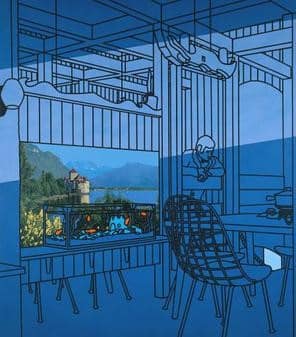Fellowships will provide support to pursue research in the fields of artificial intelligence and robotics.Read More
Hello, World: NIO Expands Global Footprint With Intelligent Vehicle Experiences
When it comes to reimagining the next generation of automotive, NIO is thinking outside the car.
This month, the China-based electric vehicle maker introduced its lineup to four new countries in Europe — Denmark, Germany, the Netherlands and Sweden — along with an innovative subscription-based ownership model. The countries join NIO’s customer base in China and Norway.
The models launching in the European market are all built on the NIO Adam supercomputer, which uses four NVIDIA DRIVE Orin systems-on-a-chip to deliver software-defined AI features.
These intelligent capabilities, which will gradually enable automated driving on expressways and urban areas, as well as autonomous parking and battery swap, are just the start of NIO’s fresh take on the vehicle ownership experience.
As the automaker expands its footprint, it is emphasizing membership rather than pure ownership. NIO vehicles are available via flexible subscription models, and customers can access club spaces, called NIO Houses, that offer a wide array of amenities.
International Supermodels
NIO’s lineup sports a premium model for every type of driver.
The flagship ET7 sedan boasts a spacious interior, with more than 620 miles of battery range and an impressive 0-to-60 miles per hour in under four seconds. For the mid-size segment, the ET5 is an EV that’s as agile as it is comfortable, borrowing the same speed and immersive interior as its predecessor in a more compact package.

Finally, the ES7 — renamed the EL7 for the European market — is an electric SUV for rugged and urban drivers alike. The intelligent EV sports 10 driving modes, including a camping mode for off-road adventures.

All three models run on the high-performance, centralized Adam supercomputer. With more than 1,000 trillion operations per second of performance provided by four DRIVE Orin SoCs, Adam can power a wide range of intelligent features, with enough headroom to add new capabilities over the air.

Using multiple SoCs, Adam integrates the redundancy and diversity necessary for safe autonomous operation. The first two SoCs process the 8GB of data produced every second by the vehicle’s sensor set.
The third Orin serves as a backup to ensure the system can operate safely in any situation. And the fourth enables local training, improving the vehicle with fleet learning and personalizing the driving experience based on individual user preferences.
While NIO’s models vary in size and design, they all share the same intelligent DNA, so every customer has access to the cutting edge in AI transportation.
A NIO Way Forward
The NIO experience doesn’t end when the drive is over — it aims to create an entire lifestyle.
Customers in new markets won’t be buying the vehicles, they’ll sign for leases as long as 60 months or as short as one month. These subscriptions include insurance, maintenance, winter tires, a courtesy car, battery swapping and the option to upgrade battery services.
The purpose of the business model is to offer the utmost flexibility, so customers always have access to the best vehicle for their needs, whatever they may be and however often they may change.
Additionally, every customer has access to the NIO House. This community space offers co-working areas, cafes, workout facilities, playrooms for children and more. NIO Houses exist in more than 80 places around the world, with locations planned for Amsterdam, Berlin, Copenhagen, Düsseldorf, Frankfurt, Gothenburg, Hamburg, Rotterdam and Stockholm.

Deliveries to the expanded European markets are scheduled to start with the ET7 sedan on Sunday, Oct. 16, with the EL7 and ET5 set to ship in January and March of 2023, respectively.
The post Hello, World: NIO Expands Global Footprint With Intelligent Vehicle Experiences appeared first on NVIDIA Blog.
SPIN: An Empirical Evaluation on Sharing Parameters of Isotropic Networks
Recent isotropic networks, such as ConvMixer and vision transformers, have found significant success across visual recognition tasks, matching or outperforming non-isotropic convolutional neural networks (CNNs). Isotropic architectures are particularly well-suited to cross-layer weight sharing, an effective neural network compression technique. In this paper, we perform an empirical evaluation on methods for sharing parameters in isotropic networks (SPIN). We present a framework to formalize major weight sharing design decisions and perform a comprehensive empirical evaluation of this design…Apple Machine Learning Research
Crossmodal-3600 — Multilingual Reference Captions for Geographically Diverse Images

Image captioning is the machine learning task of automatically generating a fluent natural language description for a given image. This task is important for improving accessibility for visually impaired users and is a core task in multimodal research encompassing both vision and language modeling.
However, datasets for image captioning are primarily available in English. Beyond that, there are only a few datasets covering a limited number of languages that represent just a small fraction of the world’s population. Further, these datasets feature images that severely under-represent the richness and diversity of cultures from across the globe. These aspects have hindered research on image captioning for a wide variety of languages, and directly hamper the deployment of accessibility solutions for a large potential audience around the world.
Today we present and make publicly available the Crossmodal 3600 (XM3600) image captioning evaluation dataset as a robust benchmark for multilingual image captioning that enables researchers to reliably compare research contributions in this emerging field. XM3600 provides 261,375 human-generated reference captions in 36 languages for a geographically diverse set of 3600 images. We show that the captions are of high quality and the style is consistent across languages.
| The Crossmodal 3600 dataset includes reference captions in 36 languages for each of a geographically diverse set of 3600 images. All images used with permission under the CC-BY 2.0 license. |
Overview of the Crossmodal 3600 Dataset
Creating large training and evaluation datasets in multiple languages is a resource-intensive endeavor. Recent work has shown that it is feasible to build multilingual image captioning models trained on machine-translated data with English captions as the starting point. However, some of the most reliable automatic metrics for image captioning are much less effective when applied to evaluation sets with translated image captions, resulting in poorer agreement with human evaluations compared to the English case. As such, trustworthy model evaluation at present can only be based on extensive human evaluation. Unfortunately, such evaluations usually cannot be replicated across different research efforts, and therefore do not offer a fast and reliable mechanism to automatically evaluate multiple model parameters and configurations (e.g., model hill climbing) or to compare multiple lines of research.
XM3600 provides 261,375 human-generated reference captions in 36 languages for a geographically diverse set of 3600 images from the Open Images dataset. We measure the quality of generated captions by comparing them to the manually provided captions using the CIDEr metric, which ranges from 0 (unrelated to the reference captions) to 10 (perfectly matching the reference captions). When comparing pairs of models, we observed strong correlations between the differences in the CIDEr scores of the model outputs, and side-by-side human evaluations comparing the model outputs. , making XM3600 is a reliable tool for high-quality automatic comparisons between image captioning models on a wide variety of languages beyond English.
Language Selection
We chose 30 languages beyond English, roughly based on their percentage of web content. In addition, we chose an additional five languages that include under-resourced languages that have many native speakers or major native languages from continents that would not be covered otherwise. Finally, we also included English as a baseline, thus resulting in a total of 36 languages, as listed in the table below.
| Arabic | Bengali* | Chinese | Croatian | Cusco Quechua* |
Czech | |||||
| Danish | Dutch | English | Filipino | Finnish | French | |||||
| German | Greek | Hebrew | Hindi | Hungarian | Indonesian | |||||
| Italian | Japanese | Korean | Maori* | Norwegian | Persian | |||||
| Polish | Portuguese | Romanian | Russian | Spanish | Swahili* | |||||
| Swedish | Telugu* | Thai | Turkish | Ukrainian | Vietnamese |
| List of languages used in XM3600. *Low-resource languages with many native speakers, or major native languages from continents that would not be covered otherwise. |
Image Selection
The images were selected from among those in the Open Images dataset that have location metadata. Since there are many regions where more than one language is spoken, and some areas are not well covered by these images, we designed an algorithm to maximize the correspondence between selected images and the regions where the targeted languages are spoken. The algorithm starts with the selection of images with geo-data corresponding to the languages for which we have the smallest pool (e.g., Persian) and processes them in increasing order of their candidate image pool size. If there aren’t enough images in an area where a language is spoken, then we gradually expand the geographic selection radius to: (i) a country where the language is spoken; (ii) a continent where the language is spoken; and, as last resort, (iii) from anywhere in the world. This strategy succeeded in providing our target number of 100 images from an appropriate region for most of the 36 languages, except for Persian (where 14 continent-level images are used) and Hindi (where all 100 images are at the global level, because the in-region images were assigned to Bengali and Telugu).
English Photo by Chris Sampson |
Swahili Photo by Henrik Palm |
Telugu Photo by rojypala |
||
Cusco Quechua Photo by McKay Savage |
Filipino Photo by Simon Schoeters |
Chinese Photo by Stefan Krasowski |
| Sample images showcasing the geographical diversity of the annotated images. Images used under CC BY 2.0 license. |
Caption Generation
In total, all 3600 images (100 images per language) are annotated in all 36 languages, each with an average of two annotations per language, yielding a total of 261,375 captions.
Annotators work in batches of 15 images. The first screen shows all 15 images with their captions in English as generated by a captioning model trained to output a consistent style of the form “<main salient objects> doing <activities> in the <environment>”, often with object attributes, such as a “smiling” person, “red” car, etc. The annotators are asked to rate the caption quality given guidelines for a 4-point scale from “excellent” to “bad”, plus an option for “not_enough_information”. This step forces the annotators to carefully assess caption quality and it primes them to internalize the style of the captions. The following screens show the images again but individually and without the English captions, and the annotators are asked to produce descriptive captions in the target language for each image.
The image batch size of 15 was chosen so that the annotators would internalize the style without remembering the exact captions. Thus, we expect the raters to generate captions based on the image content only and lacking translation artifacts. For example in the example shown below, the Spanish caption mentions “number 42” and the Thai caption mentions “convertibles”, none of which are mentioned in the English captions. The annotators were also provided with a protocol to use when creating the captions, thus achieving style consistency across languages.
 Photo by Brian Solis |
English | • A vintage sports car in a showroom with many other vintage sports cars | ||
| • The branded classic cars in a row at display | ||||
| Spanish | • Automóvil clásico deportivo en exhibición de automóviles de galería — (Classic sports car in gallery car show) | |||
| • Coche pequeño de carreras color plateado con el número 42 en una exhibición de coches — (Small silver racing car with the number 42 at a car show) | ||||
| Thai | • รถเปิดประทุนหลายสีจอดเรียงกันในที่จัดแสดง — (Multicolored convertibles line up in the exhibit) | |||
| • รถแข่งวินเทจจอดเรียงกันหลายคันในงานจัดแสดง — (Several vintage racing cars line up at the show.) |
| Sample captions in three different languages (out of 36 — see full list of captions in Appendix A of the Crossmodal-3600 paper), showcasing the creation of annotations that are consistent in style across languages, while being free of direct-translation artifacts (e.g., the Spanish “number 42” or the Thai “convertibles” would not be possible when directly translating from the English versions). Image used under CC BY 2.0 license. |
Caption Quality and Statistics
We ran two to five pilot studies per language to troubleshoot the caption generation process and to ensure high quality captions. We then manually evaluated a random subset of captions. First we randomly selected a sample of 600 images. Then, to measure the quality of captions in a particular language, for each image, we selected for evaluation one of the manually generated captions. We found that:
- For 25 out of 36 languages, the percentage of captions rated as “Good” or “Excellent” is above 90%, and the rest are all above 70%.
- For 26 out of 36 languages, the percentage of captions rated as “Bad” is below 2%, and the rest are all below 5%.
For languages that use spaces to separate words, the number of words per caption can be as low as 5 or 6 for some agglutinative languages like Cusco Quechua and Czech, and as high as 18 for an analytic language like Vietnamese. The number of characters per caption also varies drastically — from mid-20s for Korean to mid-90s for Indonesian — depending on the alphabet and the script of the language.
Empirical Evaluation and Results
We empirically measured the ability of the XM3600 annotations to rank image captioning model variations by training four variations of a multilingual image captioning model and comparing the CIDEr differences of the models’ outputs over the XM3600 dataset for 30+ languages, to side-by-side human evaluations. We observed strong correlations between the CIDEr differences and the human evaluations. These results support the use of the XM3600 references as a means to achieve high-quality automatic comparisons between image captioning models on a wide variety of languages beyond English.
Recent Uses
Recently PaLI used XM3600 to evaluate model performance beyond English for image captioning, image-to-text retrieval and text-to-image retrieval. The key takeaways they found when evaluating on XM3600 were that multilingual captioning greatly benefits from scaling the PaLI models, especially for low-resource languages.
Acknowledgements
We would like to acknowledge the coauthors of this work: Xi Chen and Radu Soricut.
Learn How NVIDIA Advances AI for Enterprises, at Oracle CloudWorld
NVIDIA and Oracle are teaming to make the power of AI accessible to enterprises across industries. These include healthcare, financial services, automotive and a broad range of natural language processing use cases driven by large language models, such as chatbots, personal assistants, document summarization and article completion.
Join NVIDIA and Oracle experts at Oracle CloudWorld, running Oct. 17-20 in Las Vegas, to learn more about technology breakthroughs and steps companies can take to unlock the potential of enterprise data with AI.
Attend the fireside chat featuring NVIDIA founder and CEO Jensen Huang and Oracle CEO Safra Catz taking place on Tuesday, Oct. 18, at 9 a.m. PT to learn how NVIDIA AI is being enabled for enterprises globally on Oracle.
NVIDIA and Oracle bring together all the key ingredients for speeding AI adoption for enterprises: the ability to securely access and manage data within Oracle’s Enterprise Data Management platforms; on-demand access to the massive computational power of NVIDIA-accelerated infrastructure at scale to build and train AI models using this data; and an NVIDIA AI developer performance-optimized stack that simplifies and accelerates building and deploying AI-enabled enterprise products and services at scale.
The NVIDIA AI platform, combined with Oracle Cloud Infrastructure, paves the way to an AI-powered enterprise, regardless of where a business is in its AI adoption journey. The platform offers GPU-accelerated deep learning frameworks, pretrained AI models, enterprise-grade software development kits and application-specific frameworks for various use cases.
Register for Oracle CloudWorld and dive into these sessions and demos to learn more:
- Keynote Fireside Address: Driving Impactful Business Results — featuring Huang and Catz, in conversation with leaders of global brands, discovering how they solve complex problems by working with Oracle. This session takes place on Tuesday, Oct. 18, from 9-10:15 a.m. PT.
- Oracle Making AI Approachable for Everyone — featuring Ian Buck, vice president of hyperscale and high-performance computing at NVIDIA, and Elad Ziklik, vice president of AI and data science services at Oracle. This session takes place on Tuesday, Oct. 18, from 11-11:45 a.m. PT.
- Achieving Database Operational Excellence Using Events and Functions at NVIDIA — featuring Chris May, senior manager at NVIDIA, and Riaz Kapadia, enterprise cloud architect at Oracle. This session takes place on Tuesday, Oct. 18, from 12:15 -1 p.m. PT.
- MLOps at Scale With Kubeflow on Oracle Cloud Infrastructure — featuring Richard Wang, senior cloud and machine learning solutions architect at NVIDIA, and Sesh Dehalisan, distinguished cloud architect at Oracle. This session takes place on Tuesday, Oct. 18, from 12:15-1 p.m. PT.
- Next-Generation AI Empowering Human Expertise — featuring Bryan Catanzaro, vice president of applied deep learning research at NVIDIA; Erich Elsen, co-founder and head of machine learning at Adept AI; and Rich Clayton, vice president of product strategy for analytics at Oracle. This session takes place on Tuesday, Oct. 18, from 12:30-1 p.m. PT.
- NVIDIA’s Migration From On-Premises to MySQL HeatWave — featuring Chris May, senior manager at NVIDIA; Radha Chinnaswamy, consultant at NVIDIA; and Sastry Vedantam, MySQL master principal solution engineer at Oracle. This session takes place on Tuesday, Oct. 18, from 4-4:45 p.m. PT.
- Scale Large Language Models With NeMo Megatron — featuring Richard Wang, senior cloud and machine learning solutions architect at NVIDIA; Anup Ojah, senior manager of cloud engineering at Oracle; and Tanina Cadwell, solutions architect at Vyasa Analytics. This session takes place on Wednesday, Oct. 19, from 11:30 a.m. to 12:15 p.m. PT.
- Serve ML Models at Scale With Triton Inference Server on OCI — featuring Richard Wang, senior cloud and machine learning solutions architect at NVIDIA, and Joanne Lei, master principal cloud architect at Oracle. This session takes place on Wednesday, Oct. 19, from 1:15-2 p.m. PT.
- Accelerating Java on the GPU — featuring Ken Hester, solutions architect director at NVIDIA, and Paul Sandoz, Java architect at Oracle. This session takes place on Thursday, Oct. 20, from 10:15-10:45 a.m. PT.
- NVIDIA AI Software for Business Outcomes: Integrating NVIDIA AI Into Your Applications — featuring Kari Briski, vice president of software product management for AI and high-performance computing software development kits at NVIDIA. This session takes place on demand.
Visit NVIDIA’s Oracle CloudWorld showcase page to discover more about NVIDIA and Oracle’s collaboration and innovations for cloud-based solutions.
The post Learn How NVIDIA Advances AI for Enterprises, at Oracle CloudWorld appeared first on NVIDIA Blog.
Press Art to Continue: New AI Tools Promise Art With the Push of a Button — But Reality Is More Complicated
Alien invasions. Gritty dystopian megacities. Battlefields swarming with superheroes. As one of Hollywood’s top concept artists, Drew Leung can visualize any world you can think of, except one where AI takes his job.
He would know. He’s spent the past few months trying to make it happen, testing every AI tool he could. “If your whole goal is to use AI to replace artists, you’ll find it really disappointing,” Leung said.
Pros and amateurs alike, however, are finding these new tools intriguing. For amateur artists — who may barely know which way to hold a paintbrush — AI gives them almost miraculous capabilities.
Thanks to AI tools such as Midjourney, OpenAI’s Dall·E, DreamStudio, and open-source software such as Stable Diffusion, AI-generated art is everywhere, spilling out across the globe through social media such as Facebook and Twitter, the tight-knit communities on Reddit and Discord, and image-sharing services like Pinterest and Instagram.
The trend has sparked an uproarious discussion in the art community. Some are relying on AI to accelerate their creative process — doing in minutes what used to take a day or more, such as instantly generating mood boards with countless iterations on a theme.
Others, citing issues with how the data used to train these systems is collected and managed, are wary. “I’m frustrated because this could be really exciting if done right,” said illustrator and concept artist Karla Ortiz, who currently refuses to use AI for art altogether.
NVIDIA’s creative team provided a taste of what these tools can do in the hands of a skilled artist during NVIDIA founder and CEO Jensen Huang’s keynote at the most recent NVIDIA GTC technology conference.

Highlights included a woman representing AI created in the drawing style of Leonardo da Vinci and an image of 19th-century English mathematician Ada Lovelace, considered by many the first computer programmer, holding a modern game controller.
More Mechanical Than Magical
After months of experimentation, Leung — known for his work on more than a score of epic movies including Black Panther and Captain America: Civil War, among other blockbusters — compares AI art tools to a “kaleidoscope” that combines colors and shapes in unexpected ways with a twist of your wrist.
Used that way, some artists say AI is most interesting when an artist pushes it hard enough to break. AI can instantly reveal visual clichés — because it fails when asked to do things it hasn’t seen before, Leung said.
And because AI tools are fed by vast quantities of data, AI can expose biases across collections of millions of images — such as poor representation of people of color — because it struggles to produce images outside a narrow ideal.
New Technologies, OId Conversations
Such promises and pitfalls put AI at the center of conversations about the intersections of technology and technique, automation and innovation, that have been going on long before AI, or even computers, existed.
After Louis-Jacques-Mandé Daguerre invented photography in 1839, painter Charles Baudelaire declared photography “art’s most mortal enemy.”
With the motto, “You push the button, we do the rest,” George Eastman’s affordable handheld cameras made photography accessible to anyone in 1888. It took years for 19th-century promoter and photographer Alfred Stieglitz, who played a key role transforming photography into an accepted art form, to come around.
Remaking More Than Art
Over the next century new technologies, like color photography, offset printmaking and digital art, inspired new movements from expressionism to surrealism, pop art to post-modernism.

The emergence of AI art continues the cycle. And the technology driving it, called transformers, like the technologies that led to past art movements, is driving changes far outside the art world.
First introduced in 2017, transformers are a type of neural network that learns context and, thus, meaning, from data. They’re now among the most vibrant areas for research in AI.
A single pretrained model can perform amazing feats — including text generation, translation and even software programming — and is the basis of the new generation of AI that can turn text into detailed images.
The diffusion models powering AI image tools, such as Dall·E and Dall·E 2, are transformer-based generative models that refine and rearrange pixels again and again until the image matches a user’s text description.
More’s coming. NVIDIA GPUs — the parallel processing engines that make modern AI possible — are being fine-tuned to support ever more powerful applications of the technology.
Introduced earlier this year, the Hopper FP8 Transformer Engine in NVIDIA’s latest GPUs will soon be embedded across vast server farms, in autonomous vehicles and in powerful desktop GPUs.
Intense Conversations
All these possibilities have sparked intense conversations.
Artist Jason Allen ignited a worldwide controversy by winning a contest at the Colorado State Fair with an AI-generated painting.
 Attorney Steven Frank has renewed old conversations in art history by using AI to reassess the authenticity of some of the world’s most mysterious artworks, such as “Salvator Mundi,” left, a painting now attributed to da Vinci.
Attorney Steven Frank has renewed old conversations in art history by using AI to reassess the authenticity of some of the world’s most mysterious artworks, such as “Salvator Mundi,” left, a painting now attributed to da Vinci.
Philosophers, ethicists and computer scientists such as Ahmed Elgammal at Rutgers University are debating if it’s possible to separate techniques that AI can mimic with the intentions of the human artists who created them.
Ortiz is among a number raising thorny questions about how the data used to train AI is collected and managed. And once an AI is trained on an image, it can’t unlearn what it’s been trained to do, Ortiz says.
Some, such as New York Times writer Kevin Roose, wonder if AI will eventually start taking away jobs from artists.
Others, such as Jason Scott, an artist and archivist at the Internet Archive, dismiss AI art as “no more dangerous than a fill tool.”
Such whirling conversations — about how new techniques and technologies change how art is made, why art is made, what it depicts, and how art, in turn, remakes us — have always been an element of art. Maybe even the most important element.
“Art is a conversation we are all invited to,” American author Rachel Hartman once wrote.
Ortiz says this means we should be thoughtful. “Are these tools assisting the artist, or are they there to be the artist?” she asked.
It’s a question all of us should ponder. Controversially, anthropologist Eric Gans connects the first act of imbuing physical objects with a special significance or meaning — the first art — to the origin of language itself.
In this context, AI will, inevitably, reshape some of humanity’s oldest conversations. Maybe even our very oldest conversation. The stakes could not be higher.
Featured image: Portrait of futuristic Ada Lovelace, playing video games, editorial photography style by NVIDIA’s creative team, using Midjourney.
The post Press Art to Continue: New AI Tools Promise Art With the Push of a Button — But Reality Is More Complicated appeared first on NVIDIA Blog.
Stopping malaria in its tracks
Developing a vaccine that could save hundreds of thousands of livesRead More
Stopping malaria in its tracks
Developing a vaccine that could save hundreds of thousands of livesRead More
Stopping malaria in its tracks
Developing a vaccine that could save hundreds of thousands of livesRead More
Stopping malaria in its tracks
Developing a vaccine that could save hundreds of thousands of livesRead More





